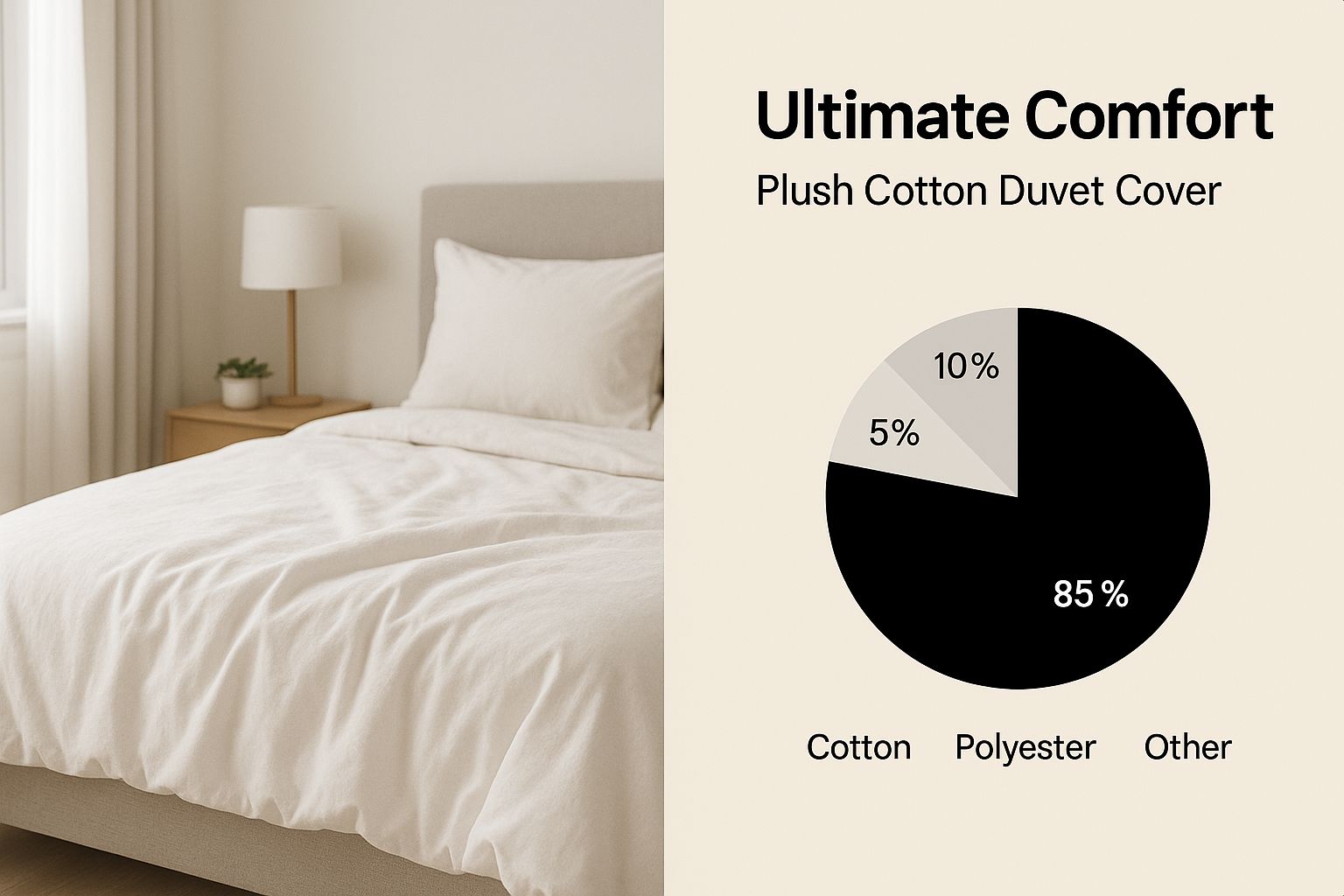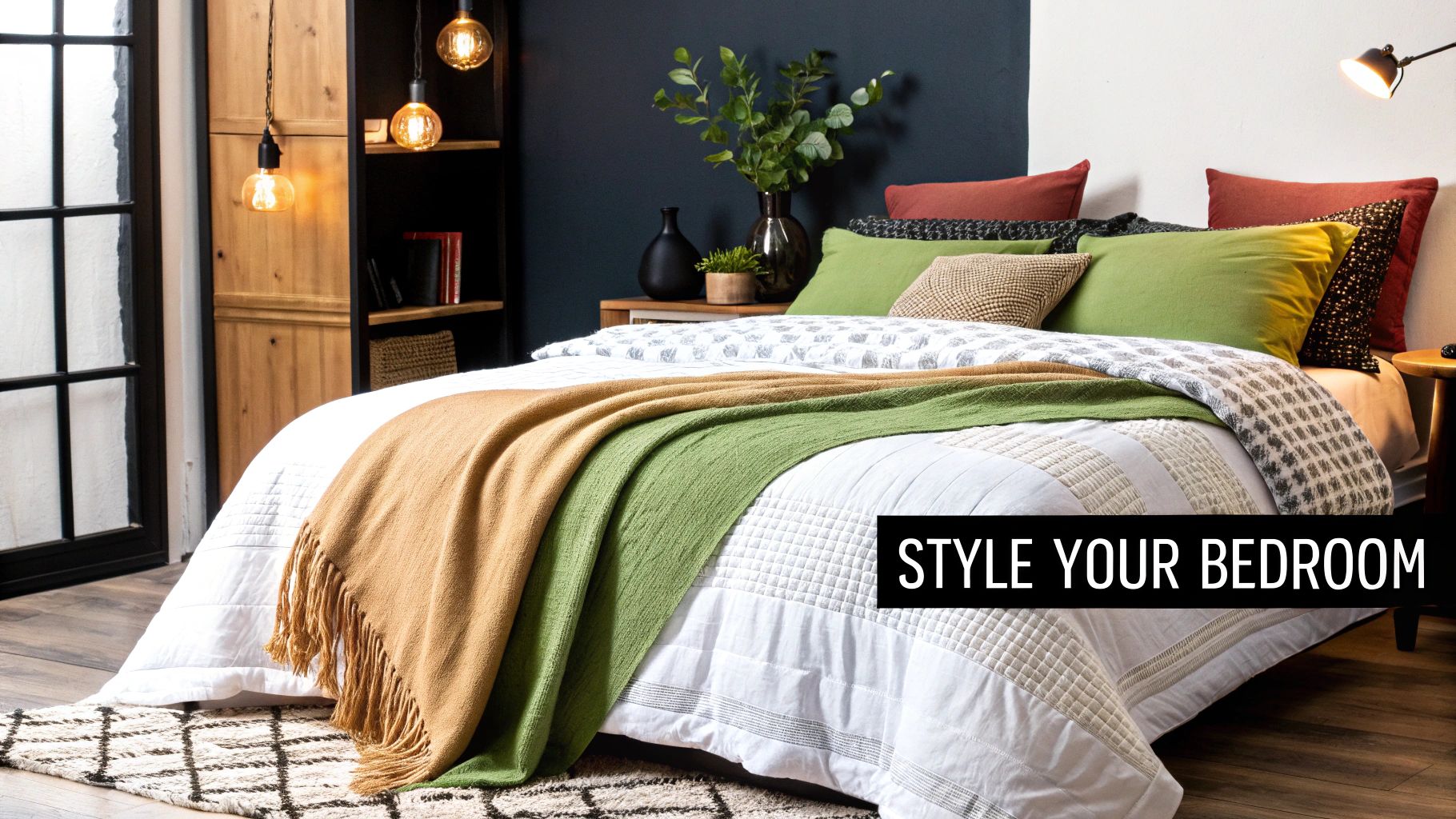At its heart, a cotton duvet cover is a simple concept: a protective and decorative sleeve for your duvet, made from the natural fibres of the cotton plant. But that simple description doesn't quite do it justice. It's renowned for its incredible breathability, softness, and durability, which is why it's consistently a top choice for anyone after high-quality, comfortable bedding.
Why a Cotton Duvet Cover Is a Smart Choice
When you're kitting out your bedroom, the fabric you choose for your bedding is probably the single most important decision you'll make. It has a direct line to your comfort, sleep quality, and even your health. While there are plenty of options out there, a cotton duvet cover really is the gold standard for good reason. It's more than just a cover; it's an investment in a good night's sleep.
Think of it like your favourite, perfectly worn-in t-shirt. You always reach for the cotton one because it feels soft, keeps you cool, and just feels right. A cotton duvet cover brings that exact same feeling to your bed, creating a sleep sanctuary you'll love sinking into.
Unmatched Comfort and Breathability
The biggest drawcard for cotton is its amazing breathability. The natural fibres create a weave that lets air move freely, so you don't get that stuffy, trapped-in heat under the covers. This natural temperature control helps keep you cool on those balmy NZ summer nights and perfectly cosy when the temperature drops.
Unlike synthetic fabrics that can often feel a bit clammy, cotton naturally wicks moisture away from your skin. This means you stay dry and comfortable all night long, creating the perfect conditions for a deep, uninterrupted sleep.
Gentle on Skin and Built to Last
If you have sensitive skin or suffer from allergies, cotton is a game-changer. It's naturally hypoallergenic, so it's far less likely to cause irritation or trigger a reaction. It’s that peace of mind that helps create a truly restful, healthy sleep space.
And let's not forget durability. A good quality cotton duvet cover is made to handle the rigours of daily life and regular washing. In fact, one of the best things about cotton is that it often gets softer and more inviting with every wash.
This infographic really captures why cotton is the last word in bedroom comfort.

As you can see, the natural qualities of the fabric all work together to create a calm and comfortable sleep environment.
It’s no surprise that cotton dominates the luxury bedding market here in New Zealand and around the world. In fact, over 60% of the luxury bedroom linen market is made up of cotton materials, a trend driven by its hypoallergenic nature and long-lasting quality. If you're interested, you can explore more about these market trends to see just how firm cotton's top spot is.
A Guide to Cotton Weaves and Types
When you're choosing a cotton duvet cover, the colour and pattern are just the beginning. The real magic happens in the details—specifically, the type of cotton used and how the fibres are woven together. Getting this right is the secret to bedding that not only looks fantastic but feels incredible.
Think of it like choosing a good bottle of wine. The grape variety (the cotton type) and the winemaking process (the weave) both have a huge impact on the final result. Let’s break down what you need to know to find the perfect duvet cover for your sleep style.
The Two Weaves That Define Your Bed's Feel
The "weave" is simply the pattern used to interlace threads into fabric. In the world of cotton bedding, two styles stand out above all others: percale and sateen. They both start with the same cotton threads, but the way they're put together creates two completely different experiences.
The Crisp, Cool Feel of Percale
Remember the satisfying feeling of a brand-new, high-quality business shirt? That's percale. It's made with a simple one-thread-over, one-thread-under grid pattern.
This tight, flat weave creates a fabric that’s light, airy, and incredibly breathable. Percale is famous for its signature crispness and cool-to-the-touch feel, making it an absolute dream for hot sleepers or anyone living in a warmer part of the country. It has a modern, matte finish—no shine here—for a clean and timeless look.
The Silky, Smooth Touch of Sateen
If percale is that crisp shirt, sateen is more like a luxurious silk blouse. It’s woven differently, usually with a one-thread-under, three-or-four-threads-over pattern. This structure lets more of the thread surface show, resulting in a fabric that's exceptionally smooth with an elegant, subtle sheen.
Sateen drapes beautifully over the bed and feels buttery soft against your skin. It has a slightly heavier weight, which gives it a cosy, insulating quality perfect for cooler nights. A great bonus? Sateen is naturally more resistant to wrinkling than percale, so it keeps its smooth look with minimal effort.
The bottom line: It all comes down to what you prefer. If you love a cool, crisp feel and a classic matte look, go for percale. If you're after a silky, smooth texture with a hint of lustre, sateen is your perfect match.
Why Not All Cotton Is Created Equal
Beyond the weave, the quality of the cotton fibre itself is a massive factor. The main difference comes down to something called staple length—which is just the length of the individual cotton fibres. Longer fibres can be spun into finer, stronger, and softer yarns, leading to more luxurious and durable bedding.
- Upland Cotton: This is the workhorse of the cotton world, making up about 90% of all cotton grown globally. It has shorter fibres, which produce reliable and affordable bedding perfect for everyday use.
- Pima Cotton: A premium variety known for its lovely long-staple fibres, Pima cotton is a step up in softness and durability. It creates a beautifully smooth and resilient fabric.
- Egyptian Cotton: Widely considered the best of the best, Egyptian cotton has extra-long-staple (ELS) fibres. These super-long fibres create an incredibly strong, soft, and lustrous fabric that resists pilling and genuinely gets softer with every wash.
It's a bit like building with LEGO bricks. You can build a sturdy wall with standard bricks (Upland cotton), and it'll do the job just fine. But if you use those longer, specialised bricks (Pima or Egyptian cotton), your wall will be smoother, stronger, and last much longer. The same goes for your duvet cover.
Cotton Weave Comparison at a Glance
Choosing between the different weaves can be tricky, so we've put together a simple table to help you see the key differences side-by-side. This should make it easier to pinpoint the exact texture and feel you're looking for.
| Weave Type | Feel & Texture | Appearance | Best For | Breathability |
|---|---|---|---|---|
| Percale | Crisp, cool, and lightweight | Matte finish, classic | Hot sleepers and warm climates | Excellent |
| Sateen | Silky, smooth, and buttery-soft | Subtle, elegant lustre | Colder sleepers and a luxurious, drapey look | Good |
Ultimately, the best cotton duvet cover is the one that feels right for you. Whether you prefer the cool, crisp embrace of percale or the silky-smooth luxury of sateen, knowing the difference means you can invest in bedding you'll be excited to jump into every single night.
What Thread Count Really Means for Quality

For years, we've been told that a high thread count is the ultimate sign of luxury bedding. It’s an easy number to market, and the logic seems simple: more threads must mean better quality. But honestly, that’s one of the biggest myths in the textile world. Chasing a high number can actually steer you away from a truly beautiful cotton duvet cover.
So, what is thread count? It’s simply the total number of threads woven into a single square inch of fabric—counting both the vertical (warp) and horizontal (weft) yarns. For example, a 300-thread-count fabric might be made from 150 threads running one way and 150 running the other. While it tells you how dense the weave is, it tells you nothing about the quality of the cotton itself.
Quality Over Quantity
Let's use an analogy. Imagine you're baking a cake. You could follow a recipe that calls for 1,000 grams of cheap, gritty flour, or one that uses 500 grams of premium, finely milled flour. Which cake do you think will taste better? It’s the one with the better ingredients, not just more of them.
The exact same principle applies to your bedding. A duvet cover made from long, silky cotton fibres at a modest 300 to 500 thread count will feel incredibly soft, breathe beautifully, and last for years. It will feel far more luxurious than a 1,000-thread-count cover woven from short, weak fibres that are prone to pilling.
The Truth About High Thread Counts
You might be wondering how manufacturers even get to those sky-high numbers. Well, it often comes down to some clever marketing maths. Some companies will twist multiple poor-quality strands together to form a single, thicker thread. They then count each of these individual, low-grade strands in the final tally, which artificially inflates the thread count without adding any real quality, softness, or durability.
A super-high thread count can even be a red flag. When you see numbers above 800, the fabric is often so dense that it feels stiff and heavy. It can trap heat and lose that wonderful, natural breathability that makes cotton so comfortable in the first place.
Instead of getting hung up on one number, it’s much smarter to look at the factors that genuinely create beautiful bedding.
- Fibre Quality: Look for long-staple cottons like Pima or Egyptian cotton. This is the number one indicator of softness and strength.
- Weave Type: How do you want your bedding to feel? A percale weave is crisp and cool, like a classic hotel sheet, while a sateen weave is silky and smooth with a slight lustre.
- Finishing Process: The way the fabric is finished after weaving makes a huge difference. A quality finish ensures it feels smooth, resists pilling, and drapes elegantly on your bed.
When you shift your focus from a single marketing number to these true markers of quality, you can see right past the hype. To dig a little deeper, you can learn more about finding the best thread count for sheets in our detailed guide. This knowledge helps you spot real craftsmanship and choose a cotton duvet cover that will bring you lasting comfort for years to come.
Caring for Your Duvet Cover to Make It Last
A beautiful cotton duvet cover is a real investment in your comfort and the look of your bedroom. Protecting that investment isn’t about complicated routines; it’s about simple, consistent care. Getting the washing, drying, and storing right is all it takes to keep your duvet cover soft, its colour vibrant, and the fabric strong for years to come.
Think of your duvet cover like a favourite piece of clothing. You wouldn’t throw a quality wool jumper in a hot wash, and your cotton bedding deserves that same thoughtful approach to keep it looking and feeling its best.
The Right Way to Wash Your Cotton Duvet Cover
Good bedding care really starts with the wash. Using the right techniques helps you dodge common problems like shrinkage, fading, and general wear and tear on the cotton fibres.
First things first, always wash your duvet cover on its own or with similar colours and fabrics. Tossing it in with heavy towels can cause pilling and rough up the surface, while dark colours might bleed. Before you start, do up any buttons or zips to stop them from snagging the fabric as it tumbles.
For the best results, stick to these simple steps:
- Choose a Gentle Detergent: A mild, liquid detergent is your best friend here. Harsh powders and bleach can be tough on cotton fibres, causing them to break down and lose their softness over time.
- Select the Right Temperature: Wash your cover in cold or warm water—around 30-40°C is perfect. Hot water might seem better for a deep clean, but it's notorious for shrinking fibres and fading colours much faster.
- Use a Gentle Cycle: A delicate cycle is much kinder to the fabric. It helps maintain the weave and protects any special details or textures.
These small tweaks make a huge difference. For a deeper dive, our complete guide on how to care for your cotton sheets has extra tips that work perfectly for duvet covers, too.
Drying Techniques for Longevity and Softness
How you dry your duvet cover is just as important as how you wash it. High heat is the number one enemy of natural cotton, often leading to shrinkage and making the fabric feel brittle.
Whenever you can, line-drying is the best choice. Nothing beats fresh air for freshening up fabric, and it does the job without any of the stress from a machine. It’s also a great way to minimise wrinkles and keep the fabric’s natural texture.
If you need to use a machine dryer, just follow these guidelines:
- Use a Low Heat Setting: Tumble dry on low or medium. Never be tempted to use the high heat setting, as it can seriously damage the fibres.
- Don't Over-Dry: This is key. Pull the duvet cover out while it’s still slightly damp. It’s the secret to avoiding those stubborn, deep-set wrinkles and a stiff feel.
- Add Dryer Balls: A few wool dryer balls will help fluff up the fabric, cut down on static, and even shorten the drying time—all without chemicals.
A common mistake is leaving bedding in the dryer until it's bone-dry. This over-drying process is what "bakes in" wrinkles and can make even the softest cotton feel rough. Pulling it out a little early makes all the difference.
Ironing and Storing Your Duvet Cover
For that crisp, hotel-fresh look, a quick iron works wonders. The trick is to iron the cover while it’s still a little bit damp, using a medium heat setting. The steam helps smooth out creases easily without scorching the fabric.
Proper storage is the final piece of the puzzle. Always make sure your duvet cover is completely clean and dry before you fold it away. A cool, dry, well-ventilated spot like a linen closet is ideal. Try to avoid storing bedding in plastic containers, as they can trap moisture and lead to mildew or yellowing.
By following these simple care rituals, you’ll ensure your beloved cotton duvet cover stays soft, inviting, and beautiful for many years.
Styling Your Bedroom with the Perfect Duvet Cover

It’s easy to think of a duvet cover as just a protective bag for your duvet, but it’s so much more than that. As the single largest piece of fabric in your bedroom, it’s the main anchor for your entire design. Getting the styling right can completely transform your space from just a room where you sleep into a genuine personal sanctuary.
Think of your cotton duvet cover as the canvas for your bedroom's personality. A simple switch of its colour, texture, or pattern can redefine the whole atmosphere, making it one of the most powerful and easy-to-change styling tools you have at your disposal.
The Power of Colour and Mood
It’s no secret that colour has a real impact on our emotions, and this is especially true in a space dedicated to rest and rejuvenation. The shade you choose for your bedding can directly influence your mood and even play a role in how well you sleep.
Soft, calming colours are a classic choice for a good reason. Hues like serene blues, gentle greens, and warm, earthy neutrals are known to promote a sense of tranquillity. They help quiet the mind and create a peaceful environment—perfect for anyone looking to turn their bedroom into a restful retreat.
But that doesn't mean you have to shy away from bolder choices. A deep charcoal or a warm terracotta can create a wonderfully cosy, enveloping feeling, practically begging you to snuggle in on a chilly night. These richer tones add a sophisticated depth to your room's character.
- For a calming retreat: Look for shades like sage green, soft grey, dusty blue, or classic white. These colours are timeless and make a room feel light and airy.
- For a cosy nest: Embrace warmer tones like amber, rust, or olive green. These colours give a room a more intimate and inviting feel.
Layering Textures for Depth and Personality
A truly beautiful bedroom engages more than just your eyes—it’s about how the space feels. Layering different textures is the secret to creating a room that looks rich, inviting, and thoughtfully put together. A room with just one texture can feel a bit sterile, but adding varied materials brings it to life.
Your smooth cotton duvet cover is the perfect foundation. From there, you can start building layers that add visual interest and tactile comfort.
A well-styled bed should make you want to reach out and touch it. Mixing different materials creates a sensory experience that transforms your bed from just a piece of furniture into a destination for comfort.
Try adding a few of these elements to build that inviting, layered look:
- A chunky knit throw: Draped casually over the end of the bed, it adds a touch of rustic charm and incredible cosiness.
- Velvet or linen cushions: Mixing cushion fabrics is a simple but highly effective trick. The soft sheen of velvet next to the natural, rumpled texture of linen creates a beautiful contrast.
- A quilted coverlet: Placed over your duvet, a coverlet adds another layer of warmth and a classic, tailored finish to the bed.
The goal is to create a contrast that still feels harmonious. The smoothness of a sateen or the crispness of a percale cotton duvet cover provides the perfect neutral backdrop for these more textured pieces.
Anchoring Your Bedroom’s Aesthetic
Whatever your personal style, the right cotton duvet cover can anchor the whole look, tying all the different elements of your room together. It sets the tone and provides a common thread that connects your furniture, art, and decor.
Minimalist Modern: For a clean, uncluttered look, you can't go wrong with a duvet cover in a solid neutral colour like white, grey, or beige. A crisp percale weave works beautifully here, enhancing the minimalist feel with its clean lines and matte finish. The focus is purely on quality and simplicity.
Cosy Farmhouse: To get that relaxed, lived-in feel, go for a natural-toned or subtly patterned duvet cover. Think soft stripes, delicate florals, or classic gingham. A washed cotton or a linen-cotton blend will have that perfectly imperfect, inviting texture that really defines this style.
Bohemian Eclectic: This style is all about mixing patterns and textures with confidence. Use your duvet cover as a bold statement piece with a vibrant pattern or a rich, earthy colour. Layer it up with mismatched cushions, macrame wall hangings, and plenty of plants to complete that free-spirited vibe.
Ultimately, your duvet cover is the heart of your bedroom’s design. By choosing a colour that speaks to you, layering textures that add comfort, and picking a style that reflects your personality, you can create a space that’s not only beautiful but truly restful.
Making a Smart Purchase in New Zealand
Finding the perfect cotton duvet cover in New Zealand can feel like a mission, especially with so many options out there, from big-box department stores to speciality online boutiques. The key to being happy with your purchase long-term is to look past the price tag and focus on what really signals quality.
This is more important than ever. We're seeing a real shift in how Kiwis buy bedding, with a clear move towards natural, comfortable fabrics like cotton. The rise of online shopping has also opened up access to premium bedding that was once harder to find. You can dig into more trends about the New Zealand bedding market on Statista.com.
Understanding Quality Certifications
So, how do you cut through all the marketing noise? Certifications are your best friend here. These independent standards give you genuine assurance about the product you're bringing into your home.
When you're shopping for cotton bedding, look for the Oeko-Tex Standard 100 label. It's a globally recognised seal of approval, and it means every single part of the product—from the fabric and thread right down to the buttons—has been tested and found to be free of harmful substances. It's a simple gut-check to ensure your new bedding is safe for you and your family.
Your Pre-Purchase Checklist
Before you click "buy," it's worth running through a quick mental checklist. A smart purchase isn't just about the item itself; it's also about the company's service and reputation. This little bit of homework can save you a lot of hassle later.
Here are a few things to lock down first:
- Read Customer Reviews: Don't just skim the star ratings. Look for reviews that talk about how the fabric actually feels, how it holds up after a few washes, and whether the colour looks the same in real life as it did online. This is where you get the real story.
- Check the Return Policy: A good, clear return policy shows a company is confident in what it sells. Make sure you know the deal, especially if you're buying sight unseen from an online store.
- Confirm the Sizing: New Zealand bed sizes can be a bit tricky. Always double-check the measurements of the duvet cover against your duvet inner to get that perfect, snug fit. For a complete guide, you can find a full breakdown of duvet cover sizes in NZ to be absolutely sure.
Choosing where you buy is just as important as what you buy. While large retailers offer convenience, boutique online stores often provide beautifully curated collections with a real focus on craftsmanship and unique, high-quality materials.
At the end of the day, buying smart is all about being informed. When you know what to look for—from important certifications to good customer policies—you can confidently choose a cotton duvet cover that not only looks fantastic but also feels amazing for years to come.
Got Questions? We've Got Answers
Stepping into the world of bedding can feel a bit overwhelming, and it's natural to have a few questions before you commit. To help you feel completely confident in your choice, we've pulled together some of the most common queries we get from shoppers here in New Zealand.
How Often Should I Be Washing My Duvet Cover?
As a general rule, popping your cotton duvet cover in the wash every one to two weeks is perfect for keeping things fresh. This simple habit takes care of the natural build-up of body oils, sweat, and dust, ensuring your bed remains a clean and healthy space.
Of course, if you have furry friends who love to snuggle up or you're prone to allergies, a weekly wash is a smart move to keep allergens to a minimum.
Is Egyptian Cotton Really Worth the Hype?
Egyptian cotton has certainly earned its stellar reputation. Its extra-long staple fibres can be spun into incredibly smooth, strong, and soft yarns, which is why it feels so luxurious and stands up to pilling far better than standard cotton.
But it’s not the only hero out there. High-quality Pima cotton shares very similar characteristics and is another fantastic choice for soft, long-lasting bedding. At the end of the day, what truly matters is the length and quality of the cotton fibre itself, not just where it was grown.
Here's a pro tip: A well-crafted Pima or Supima® cotton duvet cover will often feel better and last longer than a low-grade Egyptian cotton one. Always focus on the quality of the fibre, not just the name on the label.
Will a 100% Cotton Duvet Cover Wrinkle?
In a word, yes. Because it's a natural fibre, 100% cotton is going to wrinkle – it’s part of its charm and a sign that you've got the real deal. You'll notice that crisp weaves like percale tend to show more creases than a silky sateen.
To keep wrinkles at bay, try this simple trick: pull the cover from the dryer when it’s still just a little damp and put it straight back on your duvet. Honestly, though, many people come to love the relaxed, lived-in look of pure cotton. It just adds to that cosy, inviting feeling of a well-loved bed.
Ready to feel the difference that premium cotton can make? Come and explore the carefully selected collection of luxurious bedding at The Foxes Den. Find the perfect piece to elevate your sleep sanctuary by browsing our range at https://www.thefoxesden.co.nz.


